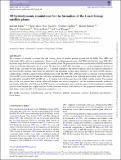Files in this item
3D hydrodynamic simulations for the formation of the local group satellite planes
Item metadata
| dc.contributor.author | Banik, Indranil | |
| dc.contributor.author | Thies, Ingo | |
| dc.contributor.author | Truelove, Roy | |
| dc.contributor.author | Candlish, Graeme | |
| dc.contributor.author | Famaey, Benoit | |
| dc.contributor.author | Pawlowski, Marcel S | |
| dc.contributor.author | Ibata, Rodrigo | |
| dc.contributor.author | Kroupa, Pavel | |
| dc.date.accessioned | 2022-05-12T15:30:19Z | |
| dc.date.available | 2022-05-12T15:30:19Z | |
| dc.date.issued | 2022-06 | |
| dc.identifier | 278549903 | |
| dc.identifier | 6d681571-a157-45aa-9141-935544c4ea5c | |
| dc.identifier | 000784328400003 | |
| dc.identifier | 85130635722 | |
| dc.identifier.citation | Banik , I , Thies , I , Truelove , R , Candlish , G , Famaey , B , Pawlowski , M S , Ibata , R & Kroupa , P 2022 , ' 3D hydrodynamic simulations for the formation of the local group satellite planes ' , Monthly Notices of the Royal Astronomical Society , vol. 513 , no. 1 , pp. 129-158 . https://doi.org/10.1093/mnras/stac722 | en |
| dc.identifier.issn | 0035-8711 | |
| dc.identifier.other | crossref: 10.1093/mnras/stac722 | |
| dc.identifier.other | ORCID: /0000-0002-4123-7325/work/113061040 | |
| dc.identifier.uri | https://hdl.handle.net/10023/25356 | |
| dc.description | Funding: IB is supported by Science and Technology Facilities Council grant ST/V000861/1. He acknowledges support from a ‘Pathways to Research’ fellowship from the University of Bonn in 2021 after an Alexander von Humboldt Foundation postdoctoral research fellowship (2018–2020). IT acknowledges support through the Stellar Populations and Dynamics research group at the University of Bonn. GC acknowledges support from Chile’s National Fund for Scientific and Technological Development (FONDECYT) Regular No. 1181708. BF and RI acknowledge funding from the Agence Nationale de la Recherche (ANR project ANR-18-CE31-0006 and ANR-19-CE31-0017) and from the European Research Council (ERC) under the European Union’s Horizon 2020 Framework Programme (grant agreement number 834148). MSP was supported by the Leibniz Junior Research Group grant J94/2020 via the Leibniz Competition, and a Klaus Tschira Boost Fund provided by the Klaus Tschira Stiftung and the German Scholars Organization. | en |
| dc.description.abstract | The existence of mutually correlated thin and rotating planes of satellite galaxies around both the Milky Way (MW) and Andromeda (M31) calls for an explanation. Previous work in Milgromian dynamics (MOND) indicated that a past MW–M31 encounter might have led to the formation of these satellite planes. We perform the first-ever hydrodynamical MOND simulation of the Local Group using PHANTOM OF RAMSES. We show that an MW–M31 encounter at z ≈ 1, with a perigalactic distance of about 80 kpc, can yield two disc galaxies at z = 0 oriented similarly to the observed galactic discs and separated similarly to the observed M31 distance. Importantly, the tidal debris are distributed in phase space similarly to the observed MW and M31 satellite planes, with the correct preferred orbital pole for both. The MW–M31 orbital geometry is consistent with the presently observed M31 proper motion despite this not being considered as a constraint when exploring the parameter space. The mass of the tidal debris around the MW and M31 at z = 0 compare well with the mass observed in their satellite systems. The remnant discs of the two galaxies have realistic radial scale lengths and velocity dispersions, and the simulation naturally produces a much hotter stellar disc in M31 than in the MW. However, reconciling this scenario with the ages of stellar populations in satellite galaxies would require that a higher fraction of stars previously formed in the outskirts of the progenitors ended up within the tidal debris, or that the MW–M31 interaction occurred at z > 1. | |
| dc.format.extent | 30 | |
| dc.format.extent | 3431533 | |
| dc.language.iso | eng | |
| dc.relation.ispartof | Monthly Notices of the Royal Astronomical Society | en |
| dc.subject | Gravitation | en |
| dc.subject | Local Group | en |
| dc.subject | Galaxies: formation | en |
| dc.subject | Galaxies: interactions | en |
| dc.subject | Galaxies: kinematics and dynamics | en |
| dc.subject | Hydrodynamics | en |
| dc.subject | QB Astronomy | en |
| dc.subject | QC Physics | en |
| dc.subject | DAS | en |
| dc.subject.lcc | QB | en |
| dc.subject.lcc | QC | en |
| dc.title | 3D hydrodynamic simulations for the formation of the local group satellite planes | en |
| dc.type | Journal article | en |
| dc.contributor.sponsor | Science & Technology Facilities Council | en |
| dc.contributor.institution | University of St Andrews. School of Physics and Astronomy | en |
| dc.identifier.doi | 10.1093/mnras/stac722 | |
| dc.description.status | Peer reviewed | en |
| dc.identifier.grantnumber | ST/V000861/1 | en |
This item appears in the following Collection(s)
Items in the St Andrews Research Repository are protected by copyright, with all rights reserved, unless otherwise indicated.

